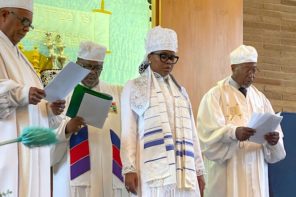“Protestant, Catholic, Jewish—We’re All Christians!”
Actually, we’re not. But to listen to Rick Santorum recently is to wonder whether the GOP candidate owns a pair of Christian-tinted glasses. They might go well with the sweater vests.
First, there was the Hanukkah card, addressed to the candidate’s Jewish supporters, which included a passage from the New Testament. (Since when had the Book of John been vaulted into the Jewish canon?) Then there was Santorum’s radio comment that, in political campaigns, “We always need a Jesus candidate.” Most recently, just before winning the state by a significant margin, Santorum was introduced to a Louisiana audience by Baptist pastor Dennis Terry, who declared America a Christian nation. “There is only one God and his name is Jesus… Listen to me, If you don’t love America, If you don’t like the way we do things I have one thing to say: GET OUT,” Terry told his audience as Santorum applauded.
Given all of this, maybe it’s not surprising that John F. Kennedy’s famous speech about the separation of church and state made him want to throw up.
Did Santorum realize that his remarks made many Americans want to throw up?
Apart from being offensive, Santorum’s remarks are revelatory of a religious worldview with distinctly post-World War II origins. In the 1950s, the portrayal of Christians and Jews as one “American religious system” united against Communist and fascist enemies was a form of patriotism. It was a legitimate view of religion in America, even if it tended toward whitewashing religious particularities.
Consider Will Herberg’s 1953 article for the Journal of the American Academy of Religion, in which he described Judaism and Christianity’s basic unity: “Judaism and Christianity are at one with each other and poles apart from the non-biblical ‘religions of the world.’” The spectrum of “good” and “bad” religions—with Judaism and Christianity on the side of good—was thus apparent. As proof of the cozy relationship now shared by Judaism and Christianity, Herberg eagerly quoted Christian and Jewish theologians who described the two as “twin religions” constituting “one system” and “[n]ot, fundamentally, two different religions but one.” Herberg argued that Judaism and Christianity were interdependent; united, notwithstanding their differences.
Was there a whiff of something fraudulent in these postwar claims of sudden intimacy between Jews and Christians? Probably. But these goodwill, ecumenical efforts represented remarkable progress. In his recent book, for example, historian Kevin Schultz shows how “Tri-faith America” replaced the notion that “Catholics and Jews are here under sufferance,” as President Roosevelt had remarked in 1942. Although the “Judeo-Christian tradition” may have been the kind of friendship offer from a Christian majority that said: “We like you because you’re basically like us,” in the immediate postwar years many Jews did not feel themselves to be in a position where they could be choosy about such friendship offers.
At the same time as postwar scholars and theologians such as Herberg and Reinhold Niebuhr elaborated on the idea of Judeo-Christianity; as President Eisenhower affirmed it in his political discourse; and as popular culture, such as the Academy Award-winning film Gentleman’s Agreement, enshrined the American-ness of Protestantism, Catholicism, and Judaism, it became apparent that not all faiths were acceptable. In Gentleman’s Agreement, Gregory Peck’s character, explaining American religion to his son Tommy, says: “See, you can be an American and a Catholic or an American and a Protestant or an American and a Jew.” Buddhists and Muslims and others were clearly not part of this inner circle.
What was less clear was how much these believers in “Tri-Faith America” were willing to acknowledge the fundamental differences between the three American religions; did accepting Judaism as part of Judeo-Christianity simply mean accepting a religion that was “basically like Christianity?” Catholic clergy, as Kevin Schultz shows, were often less willing to agree to the fundamental unity of Protestant, Catholic, and Jew.
Still, for Judaism to be invited to the table of American religions, by a majority of Protestant and Catholic leaders, in the postwar years meant the forging of a new paradigm of religious pluralism.
Political gaffes are an inevitable part of the campaign season, but they are also opportunities for gaining insight into how far we’ve come—what it is now that really turns us off a candidate (and our lunch). Due to the fact that tri-faith America is no longer a national ideal, Santorum’s retooling of Judeo-Christianity into the notion that all “good Americans” are basically Christians, feels offensive—and in view of more modern feelings about religious pluralism, that’s progress.




